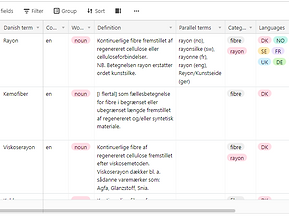Textile Terminology
The words used by past people may reveal much about their society and economy and shed light on why we use the words we use today. Terminology can be cross-cultural and used to uncover shared cultural practices from the past. Why for example do we distinguish between ‘natural’ and ‘synthetic’ fibres even though the raw material may both occur naturally, e.g. oil for the production of nylon? Why and when does one term replace another for the same material or process?
make historical terms, and by extension historical practices, available to modern readers, so that they may at least understand the context of the terms and their use.
---
This work has been made possible by a grant from Prof. Ludvig Wimmer og Hustrus legat, and has been carried out at Centre for Textile Research, the Saxo Institute, University of Copenhagen in 2022 by:
Our aim is descriptive, to document textile technical terms with their meaning and context. This is done not to determine what is the ‘right’ or ‘wrong’ term but to -.-.
Morten Grymer-Hansen (MA in history)
Susanne Lervad (PhD in specialised communication)
Mathilde Sonne (BA in history)
-.-.



